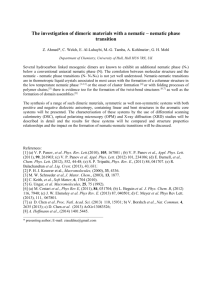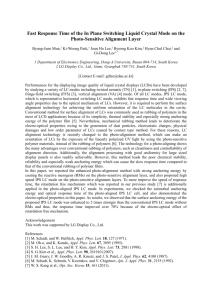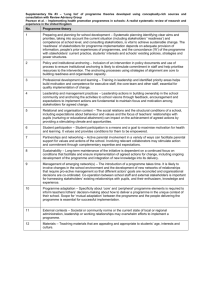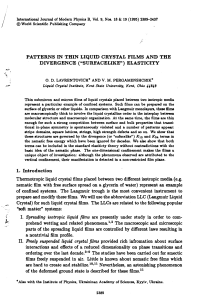Measurement of polar anchoring coefficient for nematic cell with high
advertisement
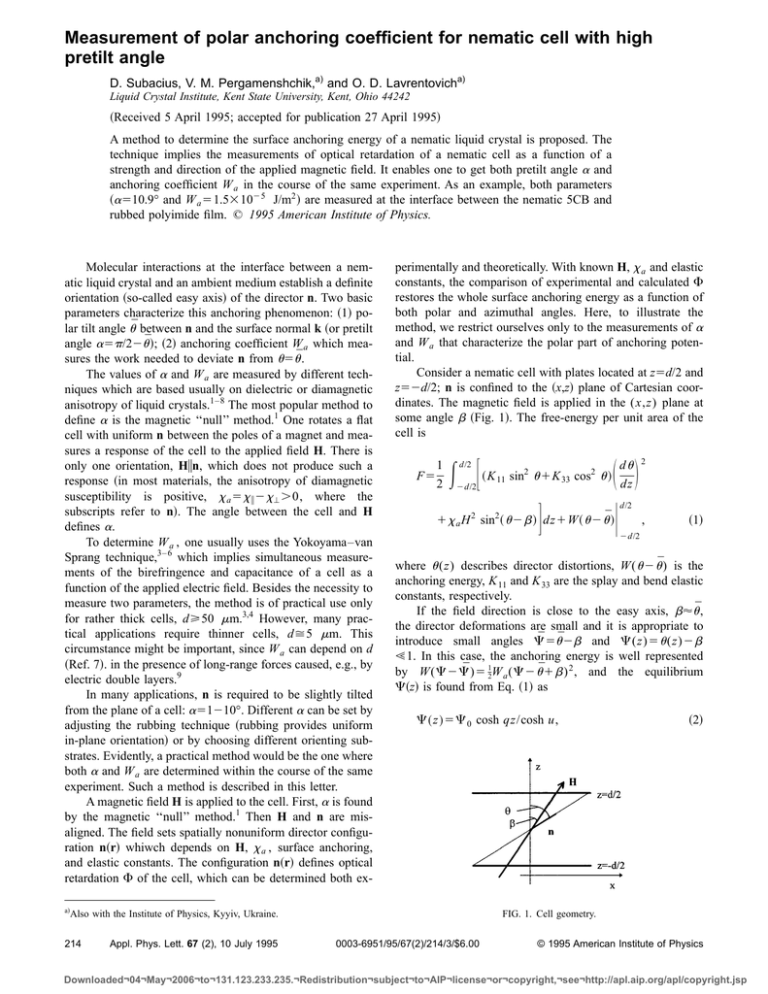
Measurement of polar anchoring coefficient for nematic cell with high pretilt angle D. Subacius, V. M. Pergamenshchik,a) and O. D. Lavrentovicha) Liquid Crystal Institute, Kent State University, Kent, Ohio 44242 ~Received 5 April 1995; accepted for publication 27 April 1995! A method to determine the surface anchoring energy of a nematic liquid crystal is proposed. The technique implies the measurements of optical retardation of a nematic cell as a function of a strength and direction of the applied magnetic field. It enables one to get both pretilt angle a and anchoring coefficient W a in the course of the same experiment. As an example, both parameters ~a510.9° and W a 51.531025 J/m2 ! are measured at the interface between the nematic 5CB and rubbed polyimide film. © 1995 American Institute of Physics. Molecular interactions at the interface between a nematic liquid crystal and an ambient medium establish a definite orientation ~so-called easy axis! of the director n. Two basic parameters characterize this anchoring phenomenon: ~1! polar tilt angle ū between n and the surface normal k ~or pretilt angle a5p/22ū !; ~2! anchoring coefficient W a which measures the work needed to deviate n from u5ū . The values of a and W a are measured by different techniques which are based usually on dielectric or diamagnetic anisotropy of liquid crystals.1– 8 The most popular method to define a is the magnetic ‘‘null’’ method.1 One rotates a flat cell with uniform n between the poles of a magnet and measures a response of the cell to the applied field H. There is only one orientation, Hin, which does not produce such a response ~in most materials, the anisotropy of diamagnetic susceptibility is positive, x a 5 x i 2 x' .0, where the subscripts refer to n!. The angle between the cell and H defines a. To determine W a , one usually uses the Yokoyama–van Sprang technique,3– 6 which implies simultaneous measurements of the birefringence and capacitance of a cell as a function of the applied electric field. Besides the necessity to measure two parameters, the method is of practical use only for rather thick cells, d>50 mm.3,4 However, many practical applications require thinner cells, d>5 mm. This circumstance might be important, since W a can depend on d ~Ref. 7!. in the presence of long-range forces caused, e.g., by electric double layers.9 In many applications, n is required to be slightly tilted from the plane of a cell: a51210°. Different a can be set by adjusting the rubbing technique ~rubbing provides uniform in-plane orientation! or by choosing different orienting substrates. Evidently, a practical method would be the one where both a and W a are determined within the course of the same experiment. Such a method is described in this letter. A magnetic field H is applied to the cell. First, a is found by the magnetic ‘‘null’’ method.1 Then H and n are misaligned. The field sets spatially nonuniform director configuration n~r! whiwch depends on H, x a , surface anchoring, and elastic constants. The configuration n~r! defines optical retardation F of the cell, which can be determined both ex- perimentally and theoretically. With known H, x a and elastic constants, the comparison of experimental and calculated F restores the whole surface anchoring energy as a function of both polar and azimuthal angles. Here, to illustrate the method, we restrict ourselves only to the measurements of a and W a that characterize the polar part of anchoring potential. Consider a nematic cell with plates located at z5d/2 and z52d/2; n is confined to the ~x,z! plane of Cartesian coordinates. The magnetic field is applied in the (x,z) plane at some angle b ~Fig. 1!. The free-energy per unit area of the cell is F5 1 2 E F d/2 2d/2 du dz 2 d/2 , ~1! 2d/2 where u (z) describes director distortions, W( u 2 ū ) is the anchoring energy, K 11 and K 33 are the splay and bend elastic constants, respectively. If the field direction is close to the easy axis, b'ū , the director deformations are small and it is appropriate to introduce small angles C̄5ū 2b and C(z)5 u (z)2 b !1. In this case, the anchoring energy is well represented by W(C2C̄)5 21W a (C2 ū 1 b ) 2 , and the equilibrium C~z! is found from Eq. ~1! as C ~ z ! 5C 0 cosh qz/cosh u, Also with the Institute of Physics, Kyyiv, Ukraine. Appl. Phys. Lett. 67 (2), 10 July 1995 G S D U 1 x a H 2 sin2 ~ u 2 b ! dz1W ~ u 2 ū ! a! 214 ~ K 11 sin2 u 1K 33 cos2 u ! ~2! FIG. 1. Cell geometry. 0003-6951/95/67(2)/214/3/$6.00 © 1995 American Institute of Physics Downloaded¬04¬May¬2006¬to¬131.123.233.235.¬Redistribution¬subject¬to¬AIP¬license¬or¬copyright,¬see¬http://apl.aip.org/apl/copyright.jsp FIG. 2. Experimental setup. where C 0 5( ū 2 b )/g, g511lq tanh u, l5K/W a , q 2 5 x a H 2 /K, u5qd/2, and K5K 11 sin2 b 1K33 cos2 b. The field-induced distortions change the retardation F of the cell. For a normally incident ~along z-axis! laser beam of wavelength l, F5 4pn0 l E S d/2 0 D ne 21 dz, n ~3! where n @ u (z) # 5 @ n 20 sin2 u(z)1n2e cos2 u(z)#1/2, n 0 and n e are the ordinary and extraordinary refractive indices, respectively. The change in F caused by the field, DF 5F u H 2F u H50 , is calculated from Eqs. ~2! and ~3!. Retaining leading terms ~linear and quadratic in the small angle C̄!, one gets DF5 F 4pA BC̄ ~ tanh u2ug ! 1CC̄ 2 lqg S 3 ug22 tanh u1 2u1sinh 2u 4g cosh2 u DG , ~4! where A5n 0 n e (n 2e 2n 20 )2n̄ 5 , B5n̄ 2 sin 2ū , C5n 2e cos2 ū 2n 20 sin2 ū 1(n 2e 2n 20 )cos2 ū sin2 ū , and n̄5n( ū ). The anchoring coefficient W a can be obtained by fitting experimental values of DF with theoretical curves @Eq. ~4!# in two independent ways; either from the dependence DF(H) when b5const or from the dependence DF~b! when H5const. Experiments were performed for the liquid crystal 5CB ~K15, EM Industries! at fixed temperature 25.0 °C. Glass substrates were spin coated with polyimide SE-610 ~Nissan Chemical Ind., Ltd. solvent NMP/Butyl cellosolve!, which is used in display industry for high-pretilt orientation. The plates were cured at 250 °C for 1 h and rubbed with rotating velvet wheel. The cells were formed by a pair of plates treated in antiparallel directions ~to set nondistorted n!. Variation in the rubbing force resulted in different pretilt angles ~a53°–13°!. Here, we report results for the cell of thickness d54.5 mm ~measured by interference method! with a510.9°. The cell was placed between the poles of electromagnet Varian V3400 ~Fig. 2!. Newport rotary stage 495 with proAppl. Phys. Lett., Vol. 67, No. 2, 10 July 1995 FIG. 3. Phase retardation DF as a function of angle b between the magnetic field H and the normal to the cell. H58.5 kGs. ~1! fitting curve, W a 51.4731025 J/m2 ; ~2! W a 53.031025 J/m2 ; and ~3! W a 50.731025 J/m2 . grammable motion controller ~model PMC200-P! was used to set different rotations of the cell with respect to the magnetic field. The linearly polarized ~45° with respect to the rubbing direction! He–Ne laser beam of diameter 1.5 mm was modulated by a chopper ~f5400– 800 Hz! and directed normally to the cell. The retardation was determined by Senarmont technique. Elliptic polarization of the beam passing through the sample was transformed into the linear one by a l/4 plate; the angle of this linear polarization was defined by rotating the analyzer to find the extinction position. Figure 3 shows the measured and calculated DF~b!. Each point represents a separate measurement; for each b, the field H was gradually increased to H58.5 kGs and then DF was measured. b was determined with accuracy of 0.1°, and DF with accuracy better than 1023 rad. The pretilt angle ~a510.9°! corresponded to DF50. The fitting of the experimental data with Eq. ~4! resulted in W a 51.47 31025 J/m2 ~standard error 0.1531025 J/m2 !. We used the values of K 11 , K 33 , and x a from Ref. 10 and refractive indices from Ref. 11. Figure 4 shows DF(H) for fixed b590°. The fitting gives W a 5(1.5460.15)31025 J/m2 , which is in good agreement with W a obtained from DF~b!. Comparison of two independent W a ’s provides an estimate of the goodness of the method. Note that the experimental conditions ~accuracy in DF, chosen cell thickness d and magnetic field strength H! allow measurements of W a up to 1023 J/m2 . This limit can be exceeded by using, e.g., stronger magnetic field. To conclude, we illustrated the method to determine the angular and energetic parameters of anchoring potential. The basic advantages of the method include the following: ~1! both a and W a are measured; ~2! W a is measured for any a and for any dielectric anistropy of liquid crystal; ~3! W a can Subacius, Pergamenshchik, and Lavrentovich 215 Downloaded¬04¬May¬2006¬to¬131.123.233.235.¬Redistribution¬subject¬to¬AIP¬license¬or¬copyright,¬see¬http://apl.aip.org/apl/copyright.jsp sitive to the errors in the measured cell thickness d. To reduce this sensitivity, one can consider the ratio DF/F u H50 rather than DF; F u H50 can be determined independently, e.g., from the temperature dependence of phase retardation. Another way to improve the accuracy is to use reflected light12 or total internal reflection mode.13 The reflection modes allow one, in addition, to eliminate the influence of a possible difference in a at the opposite plates; on the other hand, a special setup ~e.g., wedge-shaped samples or highindex prizms! is required. The method of measurements should be defined on the basis of particular practical or research needs. The authors benefited from discussion with J. Kelly and P. Palffy-Muhoray. The work was supported by NSF ALCOM Center, Grant No. DMR-20147. T. J. Scheffer and T. Nehring, J. Appl. Phys. 48, 1783 ~1977!. K. H. Yang and Ch. Rosenblatt, Appl. Phys. Lett. 43, 62 ~1983!. 3 H. Yokoyama and H. A. van Sprang, J. Appl. Phys. 57, 4520 ~1985!. 4 H. Yokoyama, Mol. Cryst. Liq. Cryst. 165, 269 ~1988!. 5 D.-S. Seo, Y. Iimura, and S. Koboyashi, Appl. Phys. Lett. 61, 234 ~1992!. 6 Y. Ji, J. R. Kelly, and J. L. West, Liq. Cryst. 14, 1885 ~1993!. 7 L. M. Blinov, A. Yu. Kabaenkov, and A. A. Sonin, Liq. Cryst. 5, 645 ~1989!. 8 J. T. Gleeson and P. Palffy-Muhoray, Liq. Cryst. 5, 663 ~1989!. 9 G. Barbero and G. Durand, J. Appl. Phys. 67, 2678 ~1990!. 10 M. J. Bradshaw, E. P. Raynes, J. D. Bunning, and T. E. Faber, J. Phys. Paris 46, 1513 ~1985!; E. Faber, J. Appl. Phys. 46, 1513 ~1985!. 11 P. P. Karat and N. V. Madhusudana, Mol. Cryst. Liq. Cryst. 36, 54 ~1976!. 12 M. Bouchiat and D. Langevin-Cruchon, Phys. Lett. A 34, 331 ~1971!; P. Chiarelli, S. Faetti, and L. Fronzoni ibid. 101, 31 ~1984!. 13 M. Warenghem, M. Ismaili, and D. Hector, J. Phys. III France 2, 765 ~1992!; F. Simoni, F. Bloisi, L. Vicari, M. Warenghem, M. Ismaili, and D. Hector, Europhys. Lett. 21, 189 ~1993!. 1 2 FIG. 4. Phase retardation DF as a function of the magnetic field H with fixed orientation b590°. ~1! fitting curve W a 51.5431025 J/m2 ; ~2! W a 53.031025 J/m2 ; and ~3! W a 50.731025 J/m2 . be measured for thin cells; ~4! two W a ’s values can be obtained independently to check the reliability of the result. The technique can be expanded to yield the whole profile of the anchoring potential; that generally would require numerical analysis similar to the one performed by Gleeson and Palffy-Muhoray.8 If unknown, the necessary parameters such as x a or elastic constants can be measured with practically the same magneto-optical setup. The technique is sen- 216 Appl. Phys. Lett., Vol. 67, No. 2, 10 July 1995 Subacius, Pergamenshchik, and Lavrentovich Downloaded¬04¬May¬2006¬to¬131.123.233.235.¬Redistribution¬subject¬to¬AIP¬license¬or¬copyright,¬see¬http://apl.aip.org/apl/copyright.jsp
